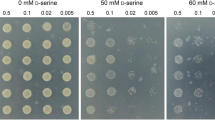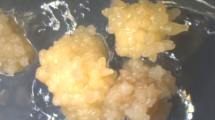Abstract
Japanese isolates ofVerticillium dahliae were examined for vegetative compatibility relationships using nitrate-nonutilizing mutants. Four levels of vegetative compatibility were differentiated according to the degree of compatibility between the tester mutants ofnit1 and NitM. Wild-type growth with a complementation line greater than 5 mm wide was defined as “strong reaction (++)”, i.e., compatible. Ten out of 15 isolates showed compatibility and were separated into three groups, provisionally designated as VCGJ1, VCGJ2, and VCGJ3, depending upon their reactions. This method was used to estimate, genetic diversity within a local population ofV. dahliae. Another 12 isolates from Gunma Pref. were paired with tester isolates of the three vegetative compatibility groups proposed. Eight Gunma isolates were assigned to VCGJ1 or VCGJ2. Two isolates were incompatible with all testers. The remaining 2 isolates were self-incompatible. Thus, 18 out of 27 Japanese isolates ofV. dahliae were assigned to VCGs: 8 to VCGJ1, 7 to VCGJ2, and 3 to VCGJ3. VCGJ1 was compatible with both VCGJ2 and VCGJ3, but VCGJ2 and VCGJ3 showed a weak reaction with each other. Japanese isolates ofV. dahliae were thus demonstrated to form a VC group comprising three subgroups.
Similar content being viewed by others
Literature cited
Bayman, P. and Cotty, P. J. 1991. Vegetative compatibility and genetic diversity in theAspergillus flavus population of a single field. Can. J. Bot.69: 1707–1711.
Brooker, N. L., Leslie, J. F. and Dickman, M. B. 1991. Nitrate non-utilizing mutants ofColletotrichum and their use in studies of vegetative compatibility and genetic relatedness. Phytopathology81:672–677.
Chen, W. 1994. Vegetative compatibility groups ofVerticillium dahliae from ornamental woody plants. Phytopathology84: 214–219.
Correll, J. C., Gordon, T. R. and McCain, A. H. 1988. Vegetative compatibility and pathogenicity ofVerticillium alboatrum. Phytopathology78: 1017–1021.
Correll, J. C., Klittich, C. J. R. and Leslie, J. F. 1987. Nitrate non-utilizing mutants ofFusarium oxysporum and their use in vegetative compatibility tests. Phytopathology77: 1640–1646.
Cove, D. J. 1976. Chlorate toxicity inAspergillus nidulans: The selection and characterization of chlorate resistant mutants. Heredity36: 191–203.
Daayf, F., Nicole, M. and Geiger, J.-P. 1995. Differentiation ofVerticillium dahliae populations on the basis of vegetative compatibility and pathogenicity on cotton. Euro. J. Plant Pathol.101: 69–79.
Gordon, T. R. and Okamoto, D. 1991. Vegetative compatibility groupings in a local population ofFusarium oxysporum. Can. J. Bot.69: 168–172.
Horiuchi, S., Hagiwara, H. and Takeuchi, S. 1990. Host specificity of isolates ofVerticillium dahliae towards Cruciferous and Solanaceous plants. In: Biological control of soil-borne plant pathogens, (ed. by Hornby, D.), pp. 285–298. CAB International Wallingford.
Iijima, T. 1983a.Verticillium diseases in Japan. Shokubutuboeki37: 89–95. (In Japanese.)
Iijima, T. 1983b. Studies onVerticillium wilt of tomato. Bull. Tokyo Metro. Agric. Exp. Stn.16: 63–128. (In Japanese.)
Isaac, I. 1957.Verticillium wilt of Brussels sprouts. Ann. Appl. Biol.45: 276–283.
Joaquim, T. R. and Rowe, R. C. 1990. Reassessment of vegetative compatibility relationships among strains ofVerticillium dahliae using nitrate-nonutilizing mutants. Phytopathology80: 1160–1166.
Joaquim, T. R. and Rowe, R. C. 1991. Vegetative compatibility and virulence of strains ofVerticillium dahliae from soil and potato plants. Phytopathology81: 552–558.
Katan, T., Zamir, D., Sarfatti, M. and Katan, J. 1991. Vegetative compatibility groups and subgroups inFusarium oxysporum f. sp.radicis-lycopersici. Phytopathology81: 255–262.
Kuhlman, E. G. and Bhattacharyya, H. 1984. Vegetative compatibility and hypovirulence conversion among naturally occurring isolates ofCryphonectria parasitica. Phytopathology74: 659–664.
Leslie, J. F. 1993. Fungal vegetative compatibility. Ann. Rev. Phytopathol.31: 127–150.
Nagao, H., Wakatabe, D. and Iijima, T. 1994. Difficulty to establish vegetative compatibility of Japanese isolates ofVerticillium dahliae Kleb using melanin synthesis-deficient mutants. J. Gen. Appl. Microbiol.44: 277–285.
Nelson, R. 1947. The specific pathogenesis of theVerticillium that causes wilt of peppermint. Phytopathology37: 17.
Puhalla, J. E. 1979. Classification of isolates ofVerticillium dahliae based on heterokaryon incompatibility. Phytopathology69: 1186–1189.
Puhalla, J. E. 1985. Classification of strains ofFusarium oxysporum on the basis of vegetative compatibility. Can. J. Bot.63: 179–183.
Puhalla, J. E. and Hummel, M. 1983. Vegetative compatibility groups withinVerticillium dahliae. Phytopathology73: 1305–1308.
Strausbaugh, C. A., Schroth, M. N., Weinhold, A. R. and Hancock, J. G. 1992. Assessment of vegetative compatibility ofVerticillium dahliae tester strains and isolates from California potatoes. Phytopathology82: 61–68.
Suwa, S., Hagiwara, H., Koumoto, M. and Kuniyasu, K. 1987. Pathogenicity of SoybeanVerticillium wilt pathogen and its pathogenicity group. Ann. Plant Pathol. Jpn53: 379. (Abstr. in Japanese.)
Author information
Authors and Affiliations
About this article
Cite this article
Wakatabe, D., Nagao, H., Arai, H. et al. Vegetative compatibility groups of Japanese isolates ofVerticillium dahliae . Mycoscience 38, 17–23 (1997). https://doi.org/10.1007/BF02464964
Accepted:
Issue Date:
DOI: https://doi.org/10.1007/BF02464964




